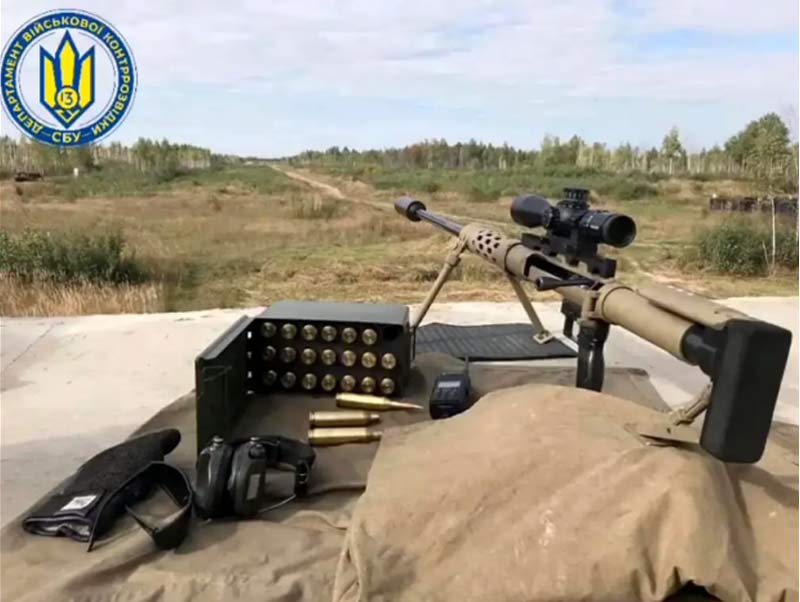Guinness World Records has become the primary international authority for cataloging and verifying countless world records. However, while it did once list Colombian Pedro López as the “most prolific serial killer” – a fact it has since removed the entry following complaints – it doesn’t actually determine who has set the record for the longest sniper kill.
It would be a hard record to verify, of course, so we’ll have to take the word of Ukrainian soldier Vyacheslav Kovalskiy, a 58-year-old former businessman-turned-sniper, who claims to have eliminated a Russian combatant from a record 12,470 feet.
The Security Service of Ukraine (SBU) first reported record achievement in a statement, announcing,” A new world record: a sniper of the SBU destroyed an orc from a distance of 3.8 km. A sniper of the SBU set a world record for a successful shot,” while adding, “SBU snipers are changing the rules of world sniping, demonstrating the ability to work effectively at fantastic distances.”
“Orc” is the term widely used by Ukraine and its supporters to describe Russian soldiers.
In an interview with The Wall Street Journal in December, Kovalskiy explained how he and his spotter pulled off a 2.36-mile shot on November 18, 2023 – and it involved sitting for hours in frigid cold weather before his spotter gave the command to fire the shot.
Both Kovalskiy and his spotter were competitive long-range shooters before the war and understood the challenges that come with taking such a long-range shot. The sniper employed a Volodar Obriyu (Horizon’s Lord) anti-material rifle (AMR), which is capable of making long-range shots and can be particularly effective when coupled with the right ammunition. The Horizon’s Lord can be configured to accept several different calibers, swapping components such as the bolt and barrel where necessary.

For the record-breaking shot, the rifle was chambered for the specialty 12.7×114 mm round, which consists of a 14.5mm cartridge case with a .50 caliber (12.7mm) bullet. The AMR was also fitted with an American barrel and suppressor, a Japanese rifle scope, and a variety of Ukrainian parts. It is just one of ten known to exist.
Making the Shot
Kovalskiy’s spotter – who has not been identified – reportedly used a laser to figure out how far away the Russian soldiers were and then determined that there was a powerful wind that would push the bullet about 200 feet from its trajectory, according to the report from the WSJ.
Moreover, the spotter had to calculate air temperature, humidity, and curvature of the earth to see how it would affect his partner’s bullet. Once the trigger was pulled it reportedly took the bullet around nine seconds to reach its target. The Wall Street Journal has reviewed video of the incident to confirm Kovalskiy’s story.
“I was thinking that Russians would now know that is what Ukrainians are capable of,” Kovalskiy told the paper of record. “Let them sit at home and be afraid.”
Since WSJ first posted the story in early December, it has made the rounds on social media – yet, there remains a high degree of skepticism.
Shots between 600-1,000 meters are considered “almost second nature,” a U.S. Marine Corps sniper previously told Business Insider about long-range shooting. “But when you are extending it to the extremes, beyond the capability of the weapon system, you have all kinds of different things to consider.”
Nichols Irving, a former sniper with the U.S. Army’s 3rd Ranger Battalion who took out 33 enemy combatants in a single deployment in Afghanistan, further said in an interview with News Nation that such a shot was technically possible – but added that the conditions would need to be “near perfect.”
“For conventional sniping, there are so many variables that are hard to quantify, so the reality is anything over about 1,300 meters [about 4,265 feet] can be more luck than skill,” Steve Walsh, a former U.S. Marines sniper instructor, told The New York Post.
However, Jonathan Ferguson, the Keeper of Firearms and Artillery at the Royal Armouries Museum in Leeds, explained how he thought the shot had been accomplished, “There’s no technical innovation in the rifle itself, it’s the ammunition choice and selection of accurate components and high standards of manufacture.”
As Ferguson also noted, the bullet could fly at supersonic speeds and is ballistically efficient, making it less sensitive to wind drift and bullet drop.
Perhaps it was a mix of skill and no shortage of luck.
Prior to Kovalskiy’s claimed kill shot, the longest recorded sniper kill was believed to have been taken by a Canadian Special Forces sniper of Joint Task Force 2 who killed an Islamic State fighter from a distance of around 2.2 miles in 2017, employing the military version of the commercially produced McMillan TAC-50 – known in the Canadian military as the C15. Canada’s military confirmed the incident but declined to reveal details for “operational security reasons.”


